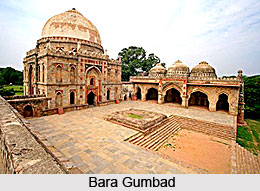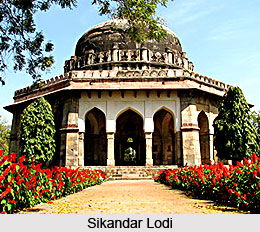 Architectures during the Sayyid Dynasty and Lodhi dynasty were class apart and defined the quality of art and craft that prevailed during that period. The construction of Islamic architecture during the Tughlaq dynasty was relaxed under the Sayyid and Lodhi rule. Due to the inheritance of greatly weakened state treasury, both the dynasties were not able to construct monumental buildings. So their desire for architectural constructions were projected in small tombs and mausoleum built throughout Delhi. The pattern of architecture during Sayyid and Lodhi dynasty was therefore restricted to tombs and sculptor only.
Architectures during the Sayyid Dynasty and Lodhi dynasty were class apart and defined the quality of art and craft that prevailed during that period. The construction of Islamic architecture during the Tughlaq dynasty was relaxed under the Sayyid and Lodhi rule. Due to the inheritance of greatly weakened state treasury, both the dynasties were not able to construct monumental buildings. So their desire for architectural constructions were projected in small tombs and mausoleum built throughout Delhi. The pattern of architecture during Sayyid and Lodhi dynasty was therefore restricted to tombs and sculptor only.
The architectures during Sayyid and Lodi dynasty made smaller influence to the cities where they ruled. Whatever they constructed mirrored the broken spirit of the rulers of both the dynasties. No famous building arts, capital cities, imperial palaces and fortresses were created during their regime at Delhi. They were also not credited for any mosques or colleges. During the entire regime of the Sayyid and Lodhi, they constructed several monuments as memorials to the dead. This architectural period during Sayyid and Lodhi dynasty was known as the period of the macabre (word probably derived from `maqbara` or the cemetery in Arabic). A large number of tombs were constructed around the capital. The three royal tombs of Mubarak Sayyid, Muhammed Sayyid and Sikandar Lodi reflect the prototype of architecture during Sayyid and Lodhi dynasty. Apart from these, other famous architectures of Sayyid and Lodi dynasties in the Delhi neighbourhood are Bara Khan ka Gumbad, Chota Khan Ka Gumbad, Shish Gumbad, Bara Gumbad, Tomb of Shihab-ud-din Taj Khan, Poli ka Gumbad and Dadi ka Gumbad.
 Architecture during Sayyid and Lodi dynasty developed a new form of Islamic architecture which was later followed by the Mughals. Sayyids and Lodis constructed the tombs in two different forms; one pattern was based on octagonal plan surrounded by arched walkway with one storey in height and the other one was based on square plan without walkway with two or three storey in height. In both the cases, the building had a dome with pillars on each side of the octagonal and the square variety. An important feature of the architecture during Sayyid and Lodi dynasty is the amazing measurements of height and width to match with the structure of the basements. The height and width of each octagonal face is thirty feet, including the basement. The ornamental pinnacles or guldasta is present at the corners. This measurement is also half the total height of the building including the finial. Each octagonal face contains three arched openings divided by pillars. The central opening of the octagonal face is slightly broader than the two other openings. The tomb chamber inside is octagonal in plan along with an "arch and beam" opening in each face. The square type tomb structure and also the octagonal type tomb structure mark the pattern of architecture during Sayyid and Lodi dynasty.
Architecture during Sayyid and Lodi dynasty developed a new form of Islamic architecture which was later followed by the Mughals. Sayyids and Lodis constructed the tombs in two different forms; one pattern was based on octagonal plan surrounded by arched walkway with one storey in height and the other one was based on square plan without walkway with two or three storey in height. In both the cases, the building had a dome with pillars on each side of the octagonal and the square variety. An important feature of the architecture during Sayyid and Lodi dynasty is the amazing measurements of height and width to match with the structure of the basements. The height and width of each octagonal face is thirty feet, including the basement. The ornamental pinnacles or guldasta is present at the corners. This measurement is also half the total height of the building including the finial. Each octagonal face contains three arched openings divided by pillars. The central opening of the octagonal face is slightly broader than the two other openings. The tomb chamber inside is octagonal in plan along with an "arch and beam" opening in each face. The square type tomb structure and also the octagonal type tomb structure mark the pattern of architecture during Sayyid and Lodi dynasty.
 Amongst the octagonal and square tombs of the architecture during Sayyid and Lodi dynasty, octagonal tombs were reserved for the rulers and the square type tombs were reserved for the nobles of their courts. All the monuments were supposed to erect within a year or two either before or after their demise. Among the several monuments found in the city, three large mausoleums are of the rulers themselves, while the others are the resting places of several nobles of their court. The architecture of the tomb building of the three rulers Mubarak Sayyid, Muhammed Sayyid and Sikandar Lodi are identical, the only exception is the crown of the dome of Mubarak Sayyid which is four feet lower than the other two tombs. They measures 30 feet each to the octagonal side, 74 feet width, and the height of the dome, excluding the finial is 54 feet, except the Mubarak Sayyid`s tomb which is 50 feet.
Amongst the octagonal and square tombs of the architecture during Sayyid and Lodi dynasty, octagonal tombs were reserved for the rulers and the square type tombs were reserved for the nobles of their courts. All the monuments were supposed to erect within a year or two either before or after their demise. Among the several monuments found in the city, three large mausoleums are of the rulers themselves, while the others are the resting places of several nobles of their court. The architecture of the tomb building of the three rulers Mubarak Sayyid, Muhammed Sayyid and Sikandar Lodi are identical, the only exception is the crown of the dome of Mubarak Sayyid which is four feet lower than the other two tombs. They measures 30 feet each to the octagonal side, 74 feet width, and the height of the dome, excluding the finial is 54 feet, except the Mubarak Sayyid`s tomb which is 50 feet.
The next architectural development of Sayyid and Lodi dynasty was the tomb of Sikandar Lodi, built in A.D. 1517. It reproduced the design of the tomb of Mohammed Sayyid.
Apart from all the three tombs of the rulers of the Sayyid and Lodi dynasty, most of the other tombs are isolated structures, without any surrounding wall, and if they were originally contained walls, these have since disappeared. Moreover away from the capital, several other architectures of the Sayyid and Lodi dynasty in same pattern are present in the towns of Kalpi in Bundelkhand and Lalitpur in the Jhansi district. The tomb present in Kalpi is known locally as the Chairs Gumbaz, popular for its Eighty-four Domes. This Islamic architecture is believed to be a tomb of one of the Lodi kings. The tomb present in Lalitpur is popular as Jama masjid.
The character and treatment of the monuments and tombs and the over all pattern of architecture during Sayyid and Lodi dynasty indicate the fact that Delhi and its surrounding area during that time attained a separate style of expressiveness through the etching, cutting and structuring of the stones which was later redefined by the Mughals.






































